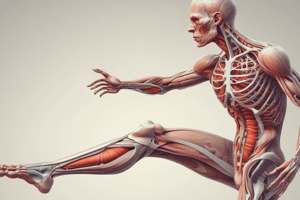Podcast
Questions and Answers
What percentage of total body weight is composed of intracellular fluids?
What percentage of total body weight is composed of intracellular fluids?
- 50%
- 28%
- 17%
- 42% (correct)
What is the term for the movement of water into or out of a cell based on the concentration of solutes?
What is the term for the movement of water into or out of a cell based on the concentration of solutes?
- Osmolysis
- Ion Transport
- Fluid Tonicity (correct)
- Electrolyte Balance
What is the primary function of the kidneys in maintaining fluid and electrolyte homeostasis?
What is the primary function of the kidneys in maintaining fluid and electrolyte homeostasis?
- Removing waste products
- Regulating electrolyte concentration (correct)
- Filtering blood
- Maintaining blood pressure
What is the term for positively charged ions?
What is the term for positively charged ions?
What is the approximate volume of intracellular fluid in a male adult?
What is the approximate volume of intracellular fluid in a male adult?
What is the normal concentration of potassium in the intravascular fluid?
What is the normal concentration of potassium in the intravascular fluid?
What would happen if a red blood cell is placed in a hypotonic solution?
What would happen if a red blood cell is placed in a hypotonic solution?
In a newborn infant, what percentage of total body fluid is extracellular fluid?
In a newborn infant, what percentage of total body fluid is extracellular fluid?
What is the primary function of sodium in the body?
What is the primary function of sodium in the body?
Which of the following patients is at risk for fluid volume excess?
Which of the following patients is at risk for fluid volume excess?
What is the normal range of sodium in the extracellular fluid?
What is the normal range of sodium in the extracellular fluid?
Why is it important to elevate extremities in patients with fluid volume excess?
Why is it important to elevate extremities in patients with fluid volume excess?
What hormone plays a key role in regulating sodium reabsorption in the renal tubule?
What hormone plays a key role in regulating sodium reabsorption in the renal tubule?
What is the term for a condition where sodium levels are too low in the body?
What is the term for a condition where sodium levels are too low in the body?
What is the primary mechanism of osmosis?
What is the primary mechanism of osmosis?
Which hormone regulates fluid intake?
Which hormone regulates fluid intake?
What is the hallmark of diabetes insipidus?
What is the hallmark of diabetes insipidus?
What is the primary cause of hypovolemia?
What is the primary cause of hypovolemia?
What is the hallmark of SIADH?
What is the hallmark of SIADH?
What is the primary mechanism of filtration?
What is the primary mechanism of filtration?
What is the primary cause of fluid volume excess?
What is the primary cause of fluid volume excess?
What is the primary function of antidiuretic hormone?
What is the primary function of antidiuretic hormone?
What is the hallmark of hypovolemia?
What is the hallmark of hypovolemia?
What is the primary mechanism of active transport?
What is the primary mechanism of active transport?
What is the primary cause of fluid volume excess (hypervolemia)?
What is the primary cause of fluid volume excess (hypervolemia)?
A patient with fluid volume deficit is expected to experience what type of pulse?
A patient with fluid volume deficit is expected to experience what type of pulse?
What is the best indicator of fluid volume status in an adult?
What is the best indicator of fluid volume status in an adult?
What is the term for the accumulation of fluid within the interstitial spaces?
What is the term for the accumulation of fluid within the interstitial spaces?
What is the primary goal of collaborative care management for fluid volume excess?
What is the primary goal of collaborative care management for fluid volume excess?
What is the term for the decrease in systolic blood pressure of more than 15 mmHg or an increase in heart rate of more than 15 beats/min?
What is the term for the decrease in systolic blood pressure of more than 15 mmHg or an increase in heart rate of more than 15 beats/min?
What is the effect of caffeine on fluid balance?
What is the effect of caffeine on fluid balance?
What is the term for the loss of water and electrolytes?
What is the term for the loss of water and electrolytes?
What is the term for the retention of water and sodium in the ECF?
What is the term for the retention of water and sodium in the ECF?
What is the primary complication of edema?
What is the primary complication of edema?
Flashcards are hidden until you start studying
Study Notes
Fluid and Electrolytes
- Distribution of body fluids:
- Intracellular fluids (ICF): 42% of total body weight, 28 liters in males, 20 liters in females
- Extracellular fluids (ECF): 17% of total body weight, consists of interstitial, intravascular, and transcellular fluids
Electrolytes
- Definition: charged particles (ions) dissolved in body fluids
- Types of electrolytes:
- Cations (positively charged): Na+, K+, Ca++, H+
- Anions (negatively charged): Cl-, HCO3-, PO43-
- Electrolyte concentration differs in ICF and ECF
Normal Electrolyte Content and Body Fluids
- Sodium (Na+): 142-146 mEq/L in ECF, 15 mEq/L in ICF
- Potassium (K+): 5 mEq/L in ECF, 150 mEq/L in ICF
- Calcium (Ca++): 5 mEq/L in ECF, 2 mEq/L in ICF
- Chloride (Cl-): 102-114 mEq/L in ECF, 1 mEq/L in ICF
- Bicarbonate (HCO3-): 27 mEq/L in ECF, 10 mEq/L in ICF
Homeostasis
- Maintained by:
- Water movement
- Ion transport
- Kidney function
- Regulation of body fluids:
- Thirst regulates fluid intake
- Fluid output: kidneys, skin, lungs, and GI tract
Fluid Movement
- Types of fluid movement:
- Diffusion: movement of dissolved particles through a semipermeable membrane
- Osmosis: diffusion of water across a selectively permeable membrane
- Filtration: movement across a membrane under pressure
- Active transport: movement of ions against osmotic pressure
Diabetes Insipidus
- Causes:
- Hypothalamic tumors, leukemia, lymphoma, sarcoidosis, head trauma, general anesthetics
- Oat-cell carcinoma of the lung, leukemia, head injury, brain tumor, pneumonia, acute respiratory failure, tuberculosis
- Pathophysiology:
- ADH deficiency leading to polyuria and polydipsia
- Inappropriate secretion of ADH with water retention
- Laboratory findings:
- Normal serum sodium and osmolarity if thirst mechanisms intact
- Low serum sodium and osmolarity if thirst mechanisms impaired
- Signs and symptoms:
- Polyuria, nocturia, continuous thirst, polydipsia, craving ice water
- Weight gain, fingerprinting edema, no peripheral edema
Hypovolemia
- Definition: fluid volume deficit occurs when loss of ECF volume exceeds intake of fluid
- Causes:
- Vomiting, diarrhea, fistulas, fever, excessive sweating, burns, blood loss, GI suction, 3rd space fluid shifts, decreased intake
- Signs and symptoms:
- Acute weight loss, decreased skin turgor, oliguria, concentrated urine, weak rapid pulse, > cap refill, low CVP, hypotension, flat neck veins, dizzy, weak, increased thirst, confusion, tachycardia, muscle cramps, sunken eyes
- Laboratory findings:
- Increased hgb and hct, increased serum and urine osmolality and specific gravity, decreased urine sodium, increased BUN and creatinine, increased urine specific gravity and osmolality
Hypervolemia
- Definition: fluid volume excess occurs when abnormal retention of water and sodium in ECF
- Causes:
- Compromised regulatory mechanisms: renal failure, heart failure, cirrhosis, overzealous admin of Na+ fluids, fluid shifts, prolonged corticosteroid therapy, severe stress, hyperaldosteronism
- Signs and symptoms:
- Acute weight gain, peripheral edema and ascites, distended jugular veins, crackles, elevated CVP, SOB, hypertension, bounding pulse, cough, tachypnea
- Laboratory findings:
- Decreased hgb and hct, decreased serum and urine osmolality, decreased urine sodium and specific gravity
Fluid Volume Deficit; Nursing Care
- Assess vital signs regularly
- Postural (orthostatic) hypotension: ↓ in sys BP > 15 mmHg or ↑ HR > 15 beats/min
- Daily weights: single best indicator of fluid volume status in adults
- Apply safety measures: orthostatic hypotension, dizziness, and falls
- Accurate record of intake and output: record drainage from body orifices and wound(s)
- Administer free water (flush) to patients receiving enteral feedings
- Urge caution in drinking coffee, tea, and colas with caffeine, which has a diuretic effect
Studying That Suits You
Use AI to generate personalized quizzes and flashcards to suit your learning preferences.



